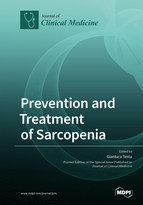Prevention and Treatment of Sarcopenia
A special issue of Journal of Clinical Medicine (ISSN 2077-0383). This special issue belongs to the section "Epidemiology & Public Health".
Deadline for manuscript submissions: closed (31 December 2020) | Viewed by 69567
Special Issue Editor
Interests: orthopaedics and traumatology; osteoporosis; sarcopenia; fall risk fragility fractures; pediatric orthopaedics; nutritional supplementations; bone disease
Special Issues, Collections and Topics in MDPI journals
Special Issue Information
Dear Colleagues,
Sarcopenia represents the decline in skeletal muscle mass and function with age, characterized by the muscle fiber's quality, strength, muscle endurance and metabolic ability decreasing as well as the fat and connective tissue growing.
Reduction of muscle strength with aging leads to loss of functional capacity, causing disability, mortality, and other adverse health outcomes. Because of the increase of proportion of elderly in the population, sarcopenia-related morbidity will become an increasing area of health care resource utilization.
Diagnostic screening consists of individuation of body composition, assessed by DEXA, anthropometry, bioelectrical impedance, MRI or CT scan. Management is possible with resistance training exercise and vibration therapy, nutritional supplements and pharmacological treatment.
I invite you to participate in this Special Issue, which aims to collect the most recent evidence of assessments and interventions for sarcopenia in the elderly. The manuscripts may include any format (data driven, systematic review, state-of-the-art review, etc.,) that may contribute to the further understanding of the role of detection, treatment and prevention. As sarcopenia represents a multidisciplinary disease, a contribution of several specialties, such as pharmacologists, biologists, physicians, radiologists, rheumatologists, orthopedics, physiotherapists, is required. The aim is to report articles about, etiology, physiopathology, diagnosis and screening, management and rehabilitation in sarcopenia.
Dr. Gianluca Testa
Guest Editor
Manuscript Submission Information
Manuscripts should be submitted online at www.mdpi.com by registering and logging in to this website. Once you are registered, click here to go to the submission form. Manuscripts can be submitted until the deadline. All submissions that pass pre-check are peer-reviewed. Accepted papers will be published continuously in the journal (as soon as accepted) and will be listed together on the special issue website. Research articles, review articles as well as short communications are invited. For planned papers, a title and short abstract (about 100 words) can be sent to the Editorial Office for announcement on this website.
Submitted manuscripts should not have been published previously, nor be under consideration for publication elsewhere (except conference proceedings papers). All manuscripts are thoroughly refereed through a single-blind peer-review process. A guide for authors and other relevant information for submission of manuscripts is available on the Instructions for Authors page. Journal of Clinical Medicine is an international peer-reviewed open access semimonthly journal published by MDPI.
Please visit the Instructions for Authors page before submitting a manuscript. The Article Processing Charge (APC) for publication in this open access journal is 2600 CHF (Swiss Francs). Submitted papers should be well formatted and use good English. Authors may use MDPI's English editing service prior to publication or during author revisions.
Keywords
- Aging
- Fall risk
- Frailty
- Muscle atrophy
- Muscle strength
- Sarcopenia
- Senescence
- Skeletal muscle mass loss







